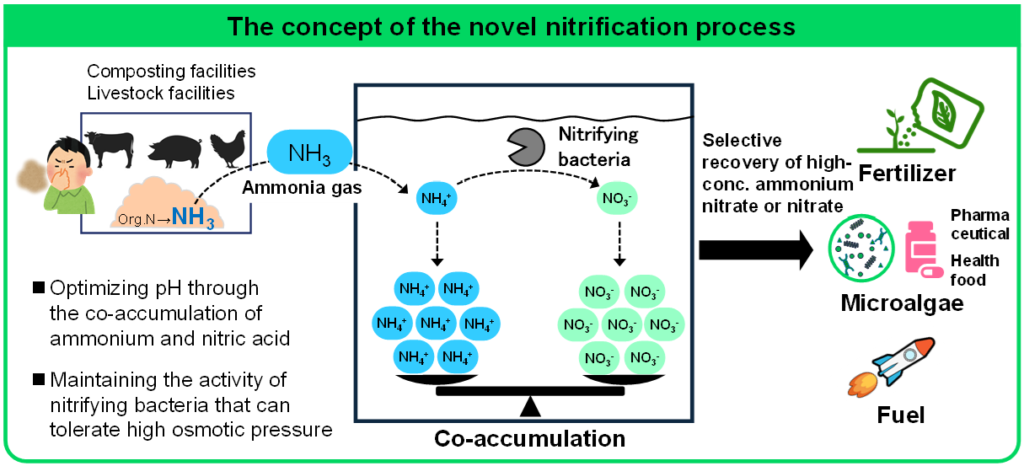Advantages
- Ammonia gas, a source of malodors at livestock farms, can be collected and converted to other uses at low cost.
- By converting it to a highly concentrated nitric acid solution, transportation costs to its destination (e.g., algae culture facilities) can be reduced.
- Contributing to the realization of a sustainable resource-recycling society.
Technology Overview & Background
Composting and livestock facilities are major sources of ammonia gas. From the perspectives of odor control and nitrogen resource recycling, there is a growing need for technology that can effectively capture and utilize ammonia gas from these sources. One existing approach involves converting ammonia into nitric acid using nitrifying bacteria, a method commonly employed to detoxify ammonia gas. However, conventional methods face challenges, including the low concentration of the resulting nitric acid, which makes its utilization economically inefficient due to transportation and other logistical factors. Furthermore, efforts to increase nitric acid concentration lead to a drop in pH, which harms the nitrifying bacteria, ultimately limiting the overall yield.
The researcher has worked to address these challenges and has developed a nitrification system that efficiently converts ammonia in flue gas into nitric acid while accumulating it at a high concentration. This system is distinguished by three key features: (I) maintaining the activity of nitrifying bacteria that can tolerate high osmotic pressure, (II) optimizing pH through the co-accumulation of ammonium and nitric acid, and (III) regulating pH using a circulating alkaline agent. By carefully controlling pH and acclimating the bacteria for this purpose, the system has successfully increased nitric acid concentrations from a few hundred mg/L to several tens of thousands mg/L, a significant improvement over conventional methods.
 |
With this technology, waste from the composting process can be repurposed as a nitrogen source for cultivating high-value-added algae, which can serve as raw materials for pharmaceuticals and health foods. Furthermore, this system enables the efficient accumulation of nitric acid at significantly higher concentrations than existing technologies, enhancing algae production efficiency while delivering substantial economic benefits. Additionally, this advanced microbial technology is not limited to composting and livestock facilities—it can also be applied to other ammonia wastewater treatment sites, such as methane fermentation plants and semiconductor manufacturing facilities. By broadening its application, this technology contributes to the development of a sustainable resource-recycling society that effectively utilizes waste materials.
Data
- A nitrifying bacteria consortium collected from a sewage treatment plant containing ammonia-oxidizing bacteria (AOB) and nitrite-oxidizing bacteria (NOB) was acclimated in an environment with a high accumulation of nitrite and nitrate ions. When ammonia water was then supplied to them, the nitrate ion concentration increased, and it was confirmed that they could accumulate as high a concentration of nitrate as approximately 29,000 mg/L. In addition, both AOB and NOB were able to proceed the nitrification reaction with high activity.
Patent(s)
Applied in Japan and not yet published. Planning to file a PCT application.
Principal Investigator & Academic Institution
Mitsuhiko Koyama, PhD (Associate Professor, Nagasaki University, Japan)
Development Stage & Future Research Plans
- The system was established to maintain high activity of nitrifying bacteria in the presence of high concentrations of ammonia and nitric acid.
- In order to achieve high concentration nitrification, the PI plans to establish selective recovery of nitric acid using electrodialysis and system stabilization operation during fluctuations in ammonia supply.
Expectations
TECH MANAGE is now looking for companies that are developing composting or wastewater treatment facilities to consider collaborating with Dr. Koyama on this invention for social implementation further.
A confidentiality agreement (CDA) allows Nagasaki University to provide unpublished data and related know-how. In addition, licensing options can be set up for evaluation of related intellectual property.
Project No.JT-05073


